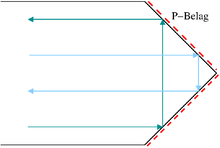Phase correction coating
The phase correction coating , also called phase correction coating ( P-coating for short ), is a thin dielectric layer that is applied to both roof surfaces of a roof prism via plasma coating in a vacuum . The P-coating was developed in 1988 by A. Weyrauch at Carl Zeiss and has since been used extensively in roof prism binoculars of medium and high quality. It is used to compensate for a loss of resolution that arises from the interference effects that occur in untreated roof prisms .
Background and functionality
Since the 1960s, hand-held binoculars whose erecting systems are based on roof prisms have become increasingly popular. This also made the solution of a technical problem that had been known since the 1940s more urgent: As reported by G. Joos at Zeiss, and independently of AI Mahan, the use of roof prisms led to a loss of resolution in the image , which was a consequence an unwanted interference revealed: The total reflection occurring in the prisms ensures a partial polarization of the beam. This bundle is then split open at the edge of the roof, whereby the two half-bundles are reflected in different directions. After all partial beams have been combined, however, their polarization vectors have different directions, which corresponds to a phase shift and leads to a loss of resolution via the interference effects mentioned. It should be noted that this phase shift also occurs in perfectly manufactured prisms, so that, unlike in the case of conventional imaging errors , it does not represent a dynamic phase based on path differences. Instead, it is a geometric phase , a consequence of the different paths on which the partial beams propagate after passing the roof edge. In technical optics, such a phase is also known as the Pancharatnam phase , and in quantum physics an equivalent phenomenon is known as the Berry phase .
The phase correction coating is applied to both roof surfaces in a vacuum thin-film process. From a technical point of view, the P-coating does not correct the actual phase shift, but rather the partial polarization of the light that results from total reflection. Such a correction can always only take place for a selected wavelength and for a specific angle of incidence; however, it is possible to approximately correct a roof prism for polychromatic light by superimposing several layers. In this way, since the 1990s, resolution values have been achieved in roof prism binoculars that were previously only achievable with Porro prisms . The presence of a P correction can also be checked on unopened binoculars using two polarization filters .
Individual evidence
- ↑ a b A. Weyrauch, B. Dörband: P- Belag : Improved imaging in binoculars through phase-corrected roof prisms. In: Deutsche Optikerzeitung. No. 4, 1988.
- ↑ G. Joos: The image deterioration by roof prisms and their elimination. In: Zeiss news. 4, 1943, p. 9.
- ↑ AI MAHAN: Focal Plane Anomalies in Roof Prisms . In: Journal of the Optical Society of America . tape 35 , no. 10 , October 1, 1945, p. 623-635 , doi : 10.1364 / JOSA.35.000623 .
- ↑ H. Merlitz: Hand binoculars: function, performance, selection. Verlag Europa-Lehrmittel, 2.A. 2019, ISBN 978-3-8085-5774-7 , p. 68.
- ↑ Shivaramakrishnan Pancharatnam : Generalized theory of interference, and its applications. Part I. Coherent pencils . In: Proceedings of the Indian Academy of Sciences, Section A . tape 44 . Indian Academy of Sciences, 1956, pp. 247-262 , doi : 10.1007 / BF03046050 .
- ^ MV Berry : The Adiabatic Phase and Pancharatnam's Phase for Polarized Light . In: Journal of Modern Optics . tape 34 , no. 11 , 1987, pp. 1401-1407 , doi : 10.1080 / 09500348714551321 .
- ^ Paul Maurer: Phase Compensation of Total Internal Reflection . In: Journal of the Optical Society of America . tape 56 , no. 9 , September 1, 1966, pp. 1219-1221 , doi : 10.1364 / JOSA.56.001219 .
- ↑ Konrad Seil: Progress in binocular design . In: SPIE Proceedings . tape 1533 , 1991, pp. 48-60 , doi : 10.1117 / 12.48843 .
